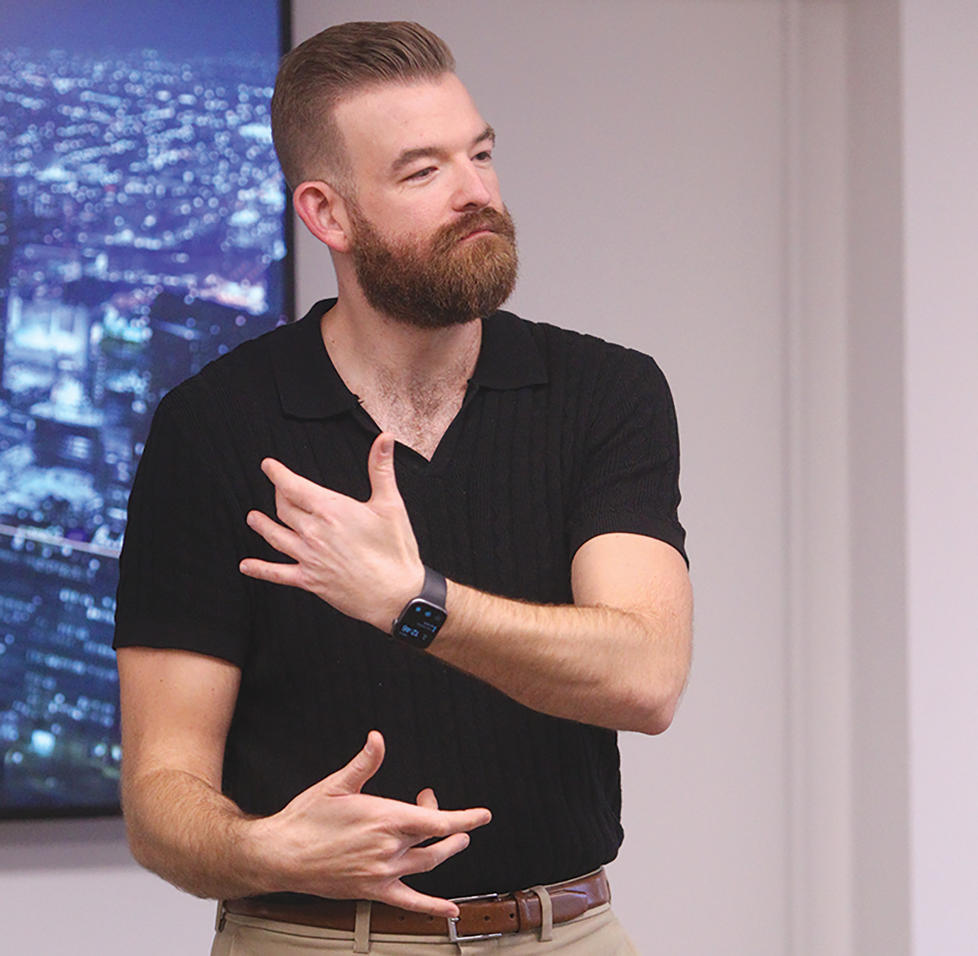Literature Class Marks New Avenue in Sign Language Studies
Senior lecturer Noah Buchholz, who is deaf, is well known on the ASL slam circuit
Princeton students enrolled in Noah Buchholz’s newest class this fall are experiencing something never previously offered at the University: a semester-long course entirely focused on American Sign Language literature. Among other genres, they are discovering the world of ASL poetry, an art form Buchholz knows intimately after years as a poet and stage performer.
Buchholz, who is deaf, is well known on the ASL slam circuit for works like “The Moonlight,” which he is in the process of filming for a wider audience, and which has also been translated into English by recent National Book Award finalist John Lee Clark.
Buchholz’s poetry reveals his mastery of the visual and expressive cadences of ASL. It also reveals the vibrant intellect that drives his work. Buchholz is currently a senior lecturer in Princeton’s Humanities Council and Program on Linguistics, as well as the course sequence head for the University’s growing ASL program. He is a translator, a certified deaf interpreter (CDI), and a Ph.D. candidate in religion and society at Princeton Theological Seminary.
This fall, Buchholz says he has been impressed by his ASL literature students. “They have done a very good job at jumping in and discussing advanced material,” he said, in an interview conducted in ASL. “That means the ASL program is doing well with preparing them for this level of conversation.”
Students enrolled in ASL 205 already have a starting grip of the language. They’ve completed Princeton’s existing four-course ASL sequence, which has fulfilled the University’s language requirement since fall 2021. Buchholz hopes the class will elevate their knowledge of ASL vocabulary and syntax while deepening their understanding of American Deaf culture (an uppercase “D” is used in references to the culture and community).
The syllabus features poems, stories, and translations by Deaf literary luminaries like Peter Cook, Clayton Valli, and Ella Mae Lentz. For one smaller assignment, students will create their own original ASL story or poem to present in class. And for their final paper, they will compose a literary analysis essay — in ASL — of one of the course’s primary texts.
“From the first week of class, we’ve discussed the concept of academic ASL,” Buchholz said. “What does it look like? How do we use ASL in academic settings?” He aspires for his students to build their expressive and academic analysis skills, drawing from his example and from classroom conversations.
ASL has long been the fastest-growing language offered in American universities, and two other lecturers currently teach at Princeton alongside Buchholz. The expanding program is the result of years of dedicated advocacy by faculty, administrators, and students like Colin Lualdi ’17, currently a Ph.D. candidate in physics at the University of Illinois Urbana-Champaign.
“We realized we needed the University to offer ASL classes, because there were so many students who wanted to learn,” said Lualdi, who is deaf and who co-founded Princeton’s ASL club as a freshman. In response to these student appeals, Campus Recreation and the Office of Disability Services stepped up as initial partners. During the spring of 2014, they tapped Buchholz to teach a set of not-for-credit ASL classes, during his final semester as a master of divinity student at the seminary.
“The interest in these classes was remarkable,” Buchholz remembered. “The classes were full instantly and there was a long waitlist.”
After finishing his M.Div. and spending three years at Bethel University in Indiana, Buchholz returned to Princeton in spring 2018 to teach ASL again, this time for credit. Enrollment consistently overflowed, even during the years before ASL counted toward Princeton’s language requirement.
ASL continues to be popular at Princeton. The waitlist for the introductory levels sometimes exceeds 150, Buchholz said. But, as Lualdi observes, Buchholz’s teaching and leadership have given Princeton students more than just an awareness of Deaf culture and different ways to communicate. They now have new linguistic tools to apply to their own professional and personal lives. “I think it’s amazing when I can talk directly with Princeton students in ASL,” he said, “to discuss science and graduate school and shared research interests.”
Serena Alagappan ’20, who took all four levels of ASL at Princeton, credits Buchholz for influencing her research interests, including the master’s thesis she wrote at Oxford about ASL poetry.
Most of Buchholz’s time is now dedicated to the ASL program, but he is also at work on his Ph.D. dissertation, which explores Black and Latin American liberation theology traditions and their frequent lack of engagement with disability. “These traditions have been central to many social justice movements, like the Civil Rights Movement in America,” he explained. “So I started to wonder: Where does disability fit in here?”
Buchholz is investigating how certain theological methods contribute to the absence of disability in these liberation theology traditions, especially considering the emphasis New Testament scriptures place on Jesus’ interactions with people who are disabled. He hopes his research will contribute to ongoing (and, in his view, much-needed) discussions about disability within religious studies.
Buchholz plans to continue his work as a poet and translator and aims to keep expanding Princeton’s ASL program by developing further classes in Deaf and disability studies. “It’s truly hard to beat the support system and the resources that exist here,” he said.












No responses yet